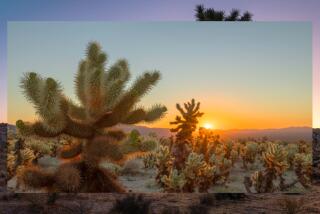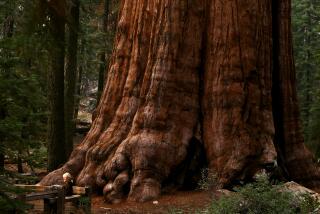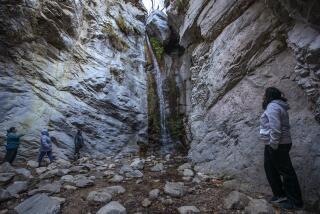Lassen Volcanic National Park is unmatched in the park system
The moment had arrived. That magical wisp of time at sunset when the earth is transformed by golden light and the sky takes on kaleidoscopic colors.
We had been following a trail around Manzanita Lake, one of the most iconic features of California’s Lassen Volcanic National Park. We’d seen a young deer eating grass beside the lake and watched a fisherman casting lines for rainbow trout.
Now, on the far side of the lake, the sun became a perfect disc, cut in half by the edge of the world. Both the sky and the lake turned crimson.
A couple of people nearby applauded. A perfect day-ender.
I had bypassed one of my favorite parks, Yosemite, last month and driven a few hours farther north to Lassen, in the northeastern corner of California. Unlike Yosemite, there were no crowds at the entrance gate, in the parking lots or on the trails.
What’s more, the 166-square-mile park turned out to be a remarkable place. Sunset Magazine calls it “The West’s most beautiful, least visited wonderland.”
Only 400,000 people will make their way to Lassen this year; nearly 4 million will visit Yosemite, most of them during the summer.
“Not many people have discovered this park,” said Karen Haner, Lassen’s chief of interpretation and education. I nodded, feeling smug: That makes the experience nicer for those of us who have discovered it.
Lassen, about a three-hour drive north of Sacramento, features jagged peaks, clear alpine lakes, quiet meadows full of wildflowers and ground that bubbles, hisses and smokes from volcanic activity.
Eruptions have rocked the region for more than 2 million years, but the spectacular landscape visitors see today began to form 100 years ago when a 30,000-foot-high volcanic blast unleashed a 12-mile-long mud flow that mowed down forests and reshaped the land.
Like the Asian volcanoes Krakatoa, Pinatubo and Mt. Fuji, Lassen is part of the Ring of Fire, a zone of mountain-building volcanoes that circle the Pacific Ocean. Here in the Pacific Northwest, Mt. Rainier, Mt. Shasta and Mt. St. Helens, which erupted in Washington in 1980, also are part of the Ring — active volcanoes with the power to explode again.
The magma seething below the surface of Lassen’s craggy mountains and quiet meadows is responsible for its tortured landscape: bubbling mud pots, shiny black lava beds and cinder cones, steaming lakes and smoking vents. It’s given the park place names such as Chaos Crags, Devil’s Kitchen and Boiling Springs Lake.
Lassen is unmatched in the park system because it contains nearly every kind of volcanic feature known.
I loved seeing these features, but I also loved taking that sunset walk around exquisite Manzanita Lake, hiking deep into the forest for a panoramic view of the Cascade Range and walking in a meadow shortly after dawn as a parade of ducklings marched by, presumably on their way to breakfast. Lassen’s assets are many and varied.
One possible problem: Where to stay? There’s only one lodge in the park, Drakesbad Guest Ranch, an aged facility that sleeps 60 in rustic cabins and a lodge. Reservations are hard to come by in July, when I visited, but late August and September are possibilities. It closes in mid-October.
Other than that, visitors can pitch a tent at eight campgrounds or drive in from nearby towns, most of which are 30 miles or more away. I opted to stay outside the park for the most part, but I tried one night at the Manzanita Lake Camping Cabins. They were a bit too rustic for me — just a thin plastic-covered mattress, a roof over my head, no electricity and a one-quarter-mile hike to a bathroom — but I met a family from Connecticut who loved them.
“We snapped it up right away,” said John Mason, a teacher traveling with wife Jennifer and their three children. Their cabin was larger than mine, with two rooms, one for them and a bunk room for the kids.
“At $70 a night, we couldn’t complain,” he said.
And when it comes right down to it, I guess I shouldn’t complain, either. If I hadn’t spent the night in the Manzanita cabin, I would have missed that spectacular sunset.
Lassen Volcanic National Park’s Bumpass Hell is a heavenly hike
The boy had plunked himself down in the middle of the trail, making it hard for me to get by.
“I’m not going any farther,” he whined, “It’s too hard. I’m going to die. “
His mother wasn’t having any of it. “You’re not going to die. Now get up and start walking. This is good for you.”
I felt a bit like the boy. It was hot, the trail was full of rocks and other hazards, and it seemed as if I should have rounded a corner to my destination long before now.
But I stopped for a minute, breathed in that clean, high-mountain air and admired the view, which stretched to the Sierra Nevada, nearly 100 miles away.
It was heavenly.
I was hiking along a three-mile trail in Lassen Volcanic National Park named Bumpass Hell, named for guide Kendall Bumpass, who discovered the area in 1864. The trail ends at a series of boiling mudpots and hot springs; Bumpass fell through the crust of one such spring, eventually losing his leg from the burns he suffered. Hell, indeed.
But the trail itself offers divine views.
From my cliff top perch, I could hear a creek tumbling over stones hundreds of feet below. A hummingbird buzzed by; a few minutes later a hawk soared across my horizon, flying out of sight.
Mt. Lassen, at 10,463 feet, loomed over the scene, small patches of snow still clinging to its high slopes. The trail ran along the edge of a bowl ringed by volcanic crags and cones, the remnants of Brokeoff Mountain, a volcano that began to crumble 10,000 years ago, eventually collapsing into itself to form the huge caldera in which I stood.
“It’s such an awesome place,” said another hiker, who was leading a band of family members along the trail. The Rothfeld clan, 15 of them from Cape Cod, Mass., were getting acquainted with Lassen.
“Huge and beautiful and quiet,” he said. “An amazing combination.”
Volcanic Legacy Scenic Byway a beautiful ride through volatile scenery
Outside, the temperature hovers around 95. But in here, it’s a cool 46 degrees. I’d be happy to stay awhile, but Subway Cave, a one-third-mile-long lava tube in Lassen National Forest, has its drawbacks. For one thing, it’s pitch-black, so when you enter cavernous Stubtoe Hall, there’s a good chance you’ll do just that.
Subway Cave, at the northeastern tip of California, is one of the sights along the Volcanic Legacy Scenic Byway (www.volcaniclegacybyway.org/home), a 500-mile drive through some of the nation’s most volatile scenery.
The volcano-to-volcano road trip begins at Lake Almanor, southeast of California’s Lassen Volcanic National Park, and heads north, eventually ending near beautiful Crater Lake National Park in Oregon (www.nps.gov/crla/index.htm).
Along the way, travelers see Mt. Shasta’s steep slopes soar to more than 14,000 feet, enjoy the 129-foot waterfall at McArthur-Burney Falls Memorial State Park (www.burney-falls.com), once described by Teddy Roosevelt as “the eighth wonder of the world,” and explore the rugged landscape of Lava Beds National Monument (www.nps.gov/labe/index.htm).
The Volcanic Legacy Scenic Byway is one of just 27 All American Roads in the United States.
Don’t forget to take a flashlight or, better yet, a headlamp, if you travel the volcanic byway. It’s preferable to taking a fall in Stubtoe Hall.
Plumas County is a happy little slice of California to visit
I always thought of Wisconsin as the Land of Lakes, but maybe that’s because a town called Land O’ Lakes is located there. And let’s not forget Minnesota, which calls itself “Land of 10,000 Lakes.”
California’s Plumas County, in the northeastern corner of the state, doesn’t make such claims. But thousands of summer visitors think of it as their land of lakes. From Lake Almanor, one of the largest artificial lakes in the state, to dozens of small mountaintop lakes and ponds in the Lakes Basin Recreation Area, Plumas County offers bountiful summer recreation.
I spent a few days getting acquainted with this happy little slice of California during a recent trip to Lassen Volcanic National Park, which borders the county. Plumas offers the park’s closest accommodations, but it’s well worth a visit on its own.
More than 75% of the county’s 2,058 square miles is national forest. There are plenty of trails to hike, lakes to swim or fish in, and campgrounds where you can pitch a tent. The Sierra Buttes, jagged peaks that have been compared to the Swiss Alps, rise impressively over the Lakes Basin, adding drama to the panorama.
Some of the county’s towns, such as Quincy, have preserved their older areas, turning historic buildings into museums and hotels. Others, such as Graeagle, have boutiques and other small shops that make shopping interesting.
With only three stoplights and a low-key lifestyle, Plumas County might make you forget the big city.
If you go to Lassen Volcanic National Park
THE BEST WAY TO LASSEN VOLCANIC NATIONAL PARK, CALIF.
From LAX, American, Southwest and Delta offer nonstop service to Sacramento, and United, Delta, US Airways, American and Alaska offer connecting service (change of planes). Restricted round-trip fares begin at $294, including taxes and fees. American, Southwest and United offer nonstop service to Reno, and United, Southwest, Delta and US Airways offer connecting service. Restricted round-trip fares begin at $226, including taxes and fees.
By car, take Interstate 5 north to Red Bluff, Calif. The park’s southwest entrance is about 45 miles east on Highway 36.
WHERE TO STAY
Manzanita Lake Camping Cabins, Manzanita Lake, Lassen Volcanic National Park; (530) 335-7557, www.lassenrecreation.com. These primitive cabins near the lake are not comfortable, but there are beds and a roof over your head in case it rains. Outdoor table, fire pit. Some cabins have porches with chairs. Sleeping bag rental, food packages available. From $69 a night.
Carson Chalets, 454 Peninsula Drive, Lake Almanor; (800) 210-7020, www.carsonchalets.com. Nicely outfitted A-frame cabins within walking distance of the lake. Full kitchens. Sleeps six, from $225 a night.
Quincy Courtyard Suites, 432 Main St., Quincy; (530) 283-1401, www.quincycourtyardsuites.com. Studio and two-bedroom suites, all with kitchen, in a converted turn-of-the-20th-century office building in Old Town Quincy. Nicely furnished, spacious. Doubles from $129 a night.
Chalet View Lodge, 72056 Highway 70, Graeagle; (800) 510-8439, www.chaletviewlodge.com. Chalet View offers some of the nicest accommodations in Plumas County, including two-room, two-bath townhouse-style suites. Pool, dining room, bar, activities. Doubles range from $109 for rooms to $210 for suites.
WHERE TO EAT
Drakesbad Guest Ranch, Warner Valley, Lassen Volcanic National Park; (866) 999-0914, www.drakesbad.com. This vintage ranch offers the only lodging inside the park and is often booked far in advance. Hearty breakfasts and lunches are served daily; stop by on your way to or from the many hiking trails in this part of the park. Lunch is $13.50.
Tantardino’s, 40 Ponderosa Drive, Lake Almanor Peninsula; (530) 596-3902, www.tantardinos.com. Guests line up nightly at this family restaurant near Lake Almanor. Dine inside or on the patio. Pizza and pasta are featured. Entrees $11 to $17.99.
Moon’s, 497 Lawrence St., Quincy; (530) 283-9900, www.moons-restaurant.com. Old Town restaurant has had many incarnations, but today’s visitors can count on being welcomed with great garlic bread, interesting salads and an eclectic mix of entrees. Try the grilled almond salad ($14.95). Entrees $13.95-$29.95.
TO LEARN MORE
Lassen Volcanic National Park, (530) 595-4480, www.nps.gov/lavo/index.htm
Plumas County Visitors Bureau, www.plumascounty.org
More to Read
Sign up for The Wild
We’ll help you find the best places to hike, bike and run, as well as the perfect silent spots for meditation and yoga.
You may occasionally receive promotional content from the Los Angeles Times.






